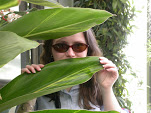Saturday, March 28, 2009
How To: Detach Sticky Roots
Labels:
in bloom,
orchid culture,
phals
Thursday, March 19, 2009
Update: Germinating orchid seeds
More spectacular microscope adventures, starring a gazillion orchid seeds!
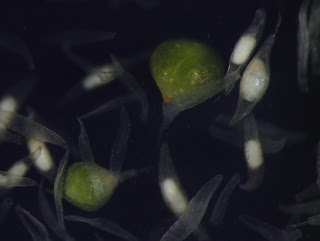 This series of photos was actually taken last Sunday, placing the time line at 4 weeks post sowing. This first one shows the Laelia tenebrosa 'Coast Ovelins' AM/AOS x self, first shown in this post. You'll see some are much further along, some are starting to swell, and some are just sitting there thinking about it. The forming protocorms (green) have now shed their seed coats. This you can still see on the top right green mass - there is the empty husk along its bottom right side. Magnification is about 38x in this photo.
This series of photos was actually taken last Sunday, placing the time line at 4 weeks post sowing. This first one shows the Laelia tenebrosa 'Coast Ovelins' AM/AOS x self, first shown in this post. You'll see some are much further along, some are starting to swell, and some are just sitting there thinking about it. The forming protocorms (green) have now shed their seed coats. This you can still see on the top right green mass - there is the empty husk along its bottom right side. Magnification is about 38x in this photo.
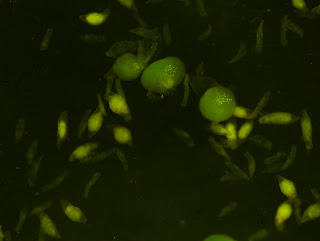
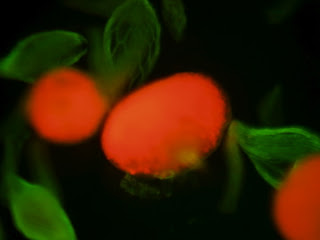
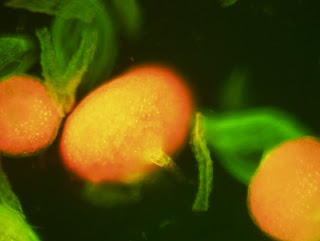 This one is Encyclia mariae, OSP #2769, magnification ~29x in the top photo, 144x in the bottom two photos, which were taken with blue light and a red-green filter. Here again you see a variety of developmental stages. The higher magnification photos also gives you a better look at the cast off seed coats, to the top right of each large protocorm. (Remember that chlorophyll naturally auto-fluoresces red under blue light, that is why they appear red in these photos) Possibly the most interesting thing about these two photos, however, is that on the bottom of the center protocorm you can see the beginnings of two nearly transparent root-like structures. I do not believe they are actual roots, but a simpler, more primitive structure. As protocorms develop, they form their first leaf and several fuzzy hairs on the other side. I suspect these are most similar to root hairs in structure, probably formed by one to a few cells each with no differentiation in terms of cell function, for the express purpose of improving water absorption over short distances. A true root has many cell types, each with its own function, shape, and location. Can anyone confirm for me the nature of the little hairs in the photo?
This one is Encyclia mariae, OSP #2769, magnification ~29x in the top photo, 144x in the bottom two photos, which were taken with blue light and a red-green filter. Here again you see a variety of developmental stages. The higher magnification photos also gives you a better look at the cast off seed coats, to the top right of each large protocorm. (Remember that chlorophyll naturally auto-fluoresces red under blue light, that is why they appear red in these photos) Possibly the most interesting thing about these two photos, however, is that on the bottom of the center protocorm you can see the beginnings of two nearly transparent root-like structures. I do not believe they are actual roots, but a simpler, more primitive structure. As protocorms develop, they form their first leaf and several fuzzy hairs on the other side. I suspect these are most similar to root hairs in structure, probably formed by one to a few cells each with no differentiation in terms of cell function, for the express purpose of improving water absorption over short distances. A true root has many cell types, each with its own function, shape, and location. Can anyone confirm for me the nature of the little hairs in the photo?
I also have plates of Cattleya leopoldii v. alba, OSP# 1383 which were sterilized and plated at the same time. Unfortunately these show no definite germination at this time, only an obvious difference between viable and not viable seeds. Not all seeds will germinate as quickly as the ones shown above. Hopefully these will start to germinate soon, too.
 This series of photos was actually taken last Sunday, placing the time line at 4 weeks post sowing. This first one shows the Laelia tenebrosa 'Coast Ovelins' AM/AOS x self, first shown in this post. You'll see some are much further along, some are starting to swell, and some are just sitting there thinking about it. The forming protocorms (green) have now shed their seed coats. This you can still see on the top right green mass - there is the empty husk along its bottom right side. Magnification is about 38x in this photo.
This series of photos was actually taken last Sunday, placing the time line at 4 weeks post sowing. This first one shows the Laelia tenebrosa 'Coast Ovelins' AM/AOS x self, first shown in this post. You'll see some are much further along, some are starting to swell, and some are just sitting there thinking about it. The forming protocorms (green) have now shed their seed coats. This you can still see on the top right green mass - there is the empty husk along its bottom right side. Magnification is about 38x in this photo.

 This one is Encyclia mariae, OSP #2769, magnification ~29x in the top photo, 144x in the bottom two photos, which were taken with blue light and a red-green filter. Here again you see a variety of developmental stages. The higher magnification photos also gives you a better look at the cast off seed coats, to the top right of each large protocorm. (Remember that chlorophyll naturally auto-fluoresces red under blue light, that is why they appear red in these photos) Possibly the most interesting thing about these two photos, however, is that on the bottom of the center protocorm you can see the beginnings of two nearly transparent root-like structures. I do not believe they are actual roots, but a simpler, more primitive structure. As protocorms develop, they form their first leaf and several fuzzy hairs on the other side. I suspect these are most similar to root hairs in structure, probably formed by one to a few cells each with no differentiation in terms of cell function, for the express purpose of improving water absorption over short distances. A true root has many cell types, each with its own function, shape, and location. Can anyone confirm for me the nature of the little hairs in the photo?
This one is Encyclia mariae, OSP #2769, magnification ~29x in the top photo, 144x in the bottom two photos, which were taken with blue light and a red-green filter. Here again you see a variety of developmental stages. The higher magnification photos also gives you a better look at the cast off seed coats, to the top right of each large protocorm. (Remember that chlorophyll naturally auto-fluoresces red under blue light, that is why they appear red in these photos) Possibly the most interesting thing about these two photos, however, is that on the bottom of the center protocorm you can see the beginnings of two nearly transparent root-like structures. I do not believe they are actual roots, but a simpler, more primitive structure. As protocorms develop, they form their first leaf and several fuzzy hairs on the other side. I suspect these are most similar to root hairs in structure, probably formed by one to a few cells each with no differentiation in terms of cell function, for the express purpose of improving water absorption over short distances. A true root has many cell types, each with its own function, shape, and location. Can anyone confirm for me the nature of the little hairs in the photo?I also have plates of Cattleya leopoldii v. alba, OSP# 1383 which were sterilized and plated at the same time. Unfortunately these show no definite germination at this time, only an obvious difference between viable and not viable seeds. Not all seeds will germinate as quickly as the ones shown above. Hopefully these will start to germinate soon, too.
Labels:
hybridization,
orchid culture
Sunday, March 15, 2009
Report on the USBG Production Facility
Once or twice per year, the US Botanic Gardens offers the opportunity to tour their production greenhouses which are on a separate location from the public greenhouses. This is where they maintain collections and produce things like the bedding plants you see around the facility. They have a wonderful collections of orchids, succulents, and more.
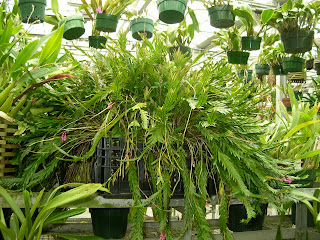
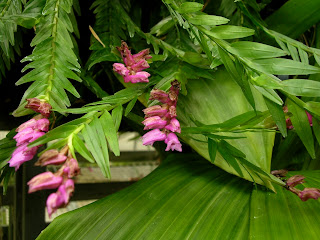 They have a great variety, but also may have multiples of the same thing - usually because they've had it long enough to divide it many times. But sometimes, they keep the plant together and just pot it into a giant milk crate, like this Isochilus major. The plastic basket it is in I'll estimate to be approximately 30 by 18 inches, maybe a bit bigger, with the plant spilling out of it in every direction.
They have a great variety, but also may have multiples of the same thing - usually because they've had it long enough to divide it many times. But sometimes, they keep the plant together and just pot it into a giant milk crate, like this Isochilus major. The plastic basket it is in I'll estimate to be approximately 30 by 18 inches, maybe a bit bigger, with the plant spilling out of it in every direction.


 There was a nice assortment of Epidendrums, but due to their octopus like nature I had a hard time identifying source pots and therefore names. So these are just interesting pictures.
There was a nice assortment of Epidendrums, but due to their octopus like nature I had a hard time identifying source pots and therefore names. So these are just interesting pictures.
 There was also quite a crop of dendrobiums, especially a large number of classic Nobile hybrids. They were all above my head so I can't give you a name on them, but they all looked rather like the old style hybrid that is slightly larger and needs colder temperatures in the winter to set buds. Still very nice of course.
There was also quite a crop of dendrobiums, especially a large number of classic Nobile hybrids. They were all above my head so I can't give you a name on them, but they all looked rather like the old style hybrid that is slightly larger and needs colder temperatures in the winter to set buds. Still very nice of course.
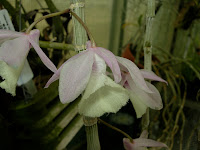
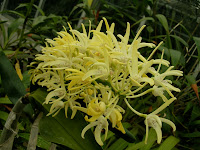 Among the dendrobiums of note were Dend. caryicola on the left, which was labeled as a CITES seizure. If you fancy it there are a number of quite similar species available, such as Dendrobium aphyllum. I'm not sure I can tell the difference between them. The photo on the right shows Dend. speciosum. This is the first time I've seen one of those in person and the plant is massive. The canes were about 2 inches in diameter and about 2 feet long topped with a pair of thick, one foot long leaves, generally looking like a large Cattleya type thing. The plant was not very attractive, but the flowers are quite nice.
Among the dendrobiums of note were Dend. caryicola on the left, which was labeled as a CITES seizure. If you fancy it there are a number of quite similar species available, such as Dendrobium aphyllum. I'm not sure I can tell the difference between them. The photo on the right shows Dend. speciosum. This is the first time I've seen one of those in person and the plant is massive. The canes were about 2 inches in diameter and about 2 feet long topped with a pair of thick, one foot long leaves, generally looking like a large Cattleya type thing. The plant was not very attractive, but the flowers are quite nice.

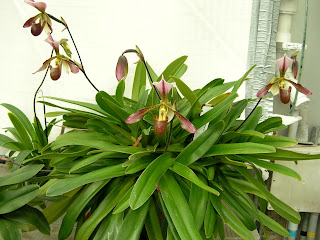 Of the many lovely paphs and phrags in bloom, there was one Paph. De Witt Smith which I was quite smitten with. I'd like to get some seedlings of this, but I suspect I'll not be able to find any. The plant is large so they've had it a while, and one sad thing about paph hybrids is that often you only see them for a short period of time and then you don't get an opportunity to buy that one ever again. With few exceptions they just don't get remade. Fortunately there are plenty of other exciting things to be growing.
Of the many lovely paphs and phrags in bloom, there was one Paph. De Witt Smith which I was quite smitten with. I'd like to get some seedlings of this, but I suspect I'll not be able to find any. The plant is large so they've had it a while, and one sad thing about paph hybrids is that often you only see them for a short period of time and then you don't get an opportunity to buy that one ever again. With few exceptions they just don't get remade. Fortunately there are plenty of other exciting things to be growing.
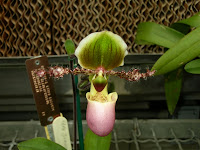
 These two closely related species are Paph. glaucophyllum and Paph. victoria-regina. These and related species and hybrids are great things to grow because they produce multiple flowers sequentially over a period of months.
These two closely related species are Paph. glaucophyllum and Paph. victoria-regina. These and related species and hybrids are great things to grow because they produce multiple flowers sequentially over a period of months.
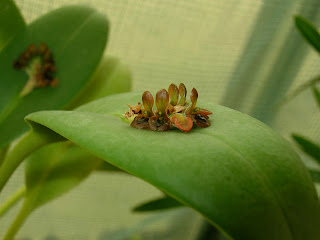 A very adorable Pleuro. circumplexa. This is a small species about 5 inches tall.
A very adorable Pleuro. circumplexa. This is a small species about 5 inches tall.
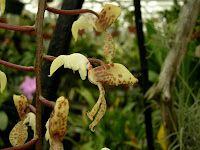
 Gongora scaphephorus, like all Gongoras, was well flowered on an elegant, pendant spike. These flowers were also nicely fragrant, but I can't remember what it smelled like. Citrus-ish, perhaps?
Gongora scaphephorus, like all Gongoras, was well flowered on an elegant, pendant spike. These flowers were also nicely fragrant, but I can't remember what it smelled like. Citrus-ish, perhaps?
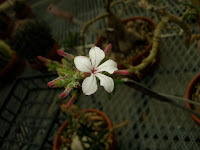
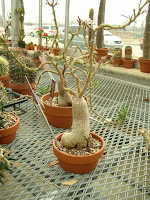
I will leave you with a couple photos from the succulent house. Above is Pachypodium succulentum, an interesting caudiciform species. I've never grown this one but have been pleased with the other Pachypodium species I have tried. They seem hardier than the more commonly seen Adeniums in my opinion.
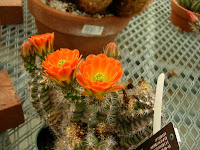 A violently red-orange Echinocereus triolochidatus in full bloom.
A violently red-orange Echinocereus triolochidatus in full bloom.
They have many other plants in other greenhouses - gingers, anthuriums, bedding plants, cycads and more. Visiting the main public complex located next to the capitol building in DC will give you quite a display and impression of the variety of their collection. I highly recommend it!

 They have a great variety, but also may have multiples of the same thing - usually because they've had it long enough to divide it many times. But sometimes, they keep the plant together and just pot it into a giant milk crate, like this Isochilus major. The plastic basket it is in I'll estimate to be approximately 30 by 18 inches, maybe a bit bigger, with the plant spilling out of it in every direction.
They have a great variety, but also may have multiples of the same thing - usually because they've had it long enough to divide it many times. But sometimes, they keep the plant together and just pot it into a giant milk crate, like this Isochilus major. The plastic basket it is in I'll estimate to be approximately 30 by 18 inches, maybe a bit bigger, with the plant spilling out of it in every direction.

 There was a nice assortment of Epidendrums, but due to their octopus like nature I had a hard time identifying source pots and therefore names. So these are just interesting pictures.
There was a nice assortment of Epidendrums, but due to their octopus like nature I had a hard time identifying source pots and therefore names. So these are just interesting pictures. There was also quite a crop of dendrobiums, especially a large number of classic Nobile hybrids. They were all above my head so I can't give you a name on them, but they all looked rather like the old style hybrid that is slightly larger and needs colder temperatures in the winter to set buds. Still very nice of course.
There was also quite a crop of dendrobiums, especially a large number of classic Nobile hybrids. They were all above my head so I can't give you a name on them, but they all looked rather like the old style hybrid that is slightly larger and needs colder temperatures in the winter to set buds. Still very nice of course.
 Among the dendrobiums of note were Dend. caryicola on the left, which was labeled as a CITES seizure. If you fancy it there are a number of quite similar species available, such as Dendrobium aphyllum. I'm not sure I can tell the difference between them. The photo on the right shows Dend. speciosum. This is the first time I've seen one of those in person and the plant is massive. The canes were about 2 inches in diameter and about 2 feet long topped with a pair of thick, one foot long leaves, generally looking like a large Cattleya type thing. The plant was not very attractive, but the flowers are quite nice.
Among the dendrobiums of note were Dend. caryicola on the left, which was labeled as a CITES seizure. If you fancy it there are a number of quite similar species available, such as Dendrobium aphyllum. I'm not sure I can tell the difference between them. The photo on the right shows Dend. speciosum. This is the first time I've seen one of those in person and the plant is massive. The canes were about 2 inches in diameter and about 2 feet long topped with a pair of thick, one foot long leaves, generally looking like a large Cattleya type thing. The plant was not very attractive, but the flowers are quite nice.
 Of the many lovely paphs and phrags in bloom, there was one Paph. De Witt Smith which I was quite smitten with. I'd like to get some seedlings of this, but I suspect I'll not be able to find any. The plant is large so they've had it a while, and one sad thing about paph hybrids is that often you only see them for a short period of time and then you don't get an opportunity to buy that one ever again. With few exceptions they just don't get remade. Fortunately there are plenty of other exciting things to be growing.
Of the many lovely paphs and phrags in bloom, there was one Paph. De Witt Smith which I was quite smitten with. I'd like to get some seedlings of this, but I suspect I'll not be able to find any. The plant is large so they've had it a while, and one sad thing about paph hybrids is that often you only see them for a short period of time and then you don't get an opportunity to buy that one ever again. With few exceptions they just don't get remade. Fortunately there are plenty of other exciting things to be growing.
 These two closely related species are Paph. glaucophyllum and Paph. victoria-regina. These and related species and hybrids are great things to grow because they produce multiple flowers sequentially over a period of months.
These two closely related species are Paph. glaucophyllum and Paph. victoria-regina. These and related species and hybrids are great things to grow because they produce multiple flowers sequentially over a period of months. A very adorable Pleuro. circumplexa. This is a small species about 5 inches tall.
A very adorable Pleuro. circumplexa. This is a small species about 5 inches tall.
 Gongora scaphephorus, like all Gongoras, was well flowered on an elegant, pendant spike. These flowers were also nicely fragrant, but I can't remember what it smelled like. Citrus-ish, perhaps?
Gongora scaphephorus, like all Gongoras, was well flowered on an elegant, pendant spike. These flowers were also nicely fragrant, but I can't remember what it smelled like. Citrus-ish, perhaps?

I will leave you with a couple photos from the succulent house. Above is Pachypodium succulentum, an interesting caudiciform species. I've never grown this one but have been pleased with the other Pachypodium species I have tried. They seem hardier than the more commonly seen Adeniums in my opinion.
 A violently red-orange Echinocereus triolochidatus in full bloom.
A violently red-orange Echinocereus triolochidatus in full bloom.They have many other plants in other greenhouses - gingers, anthuriums, bedding plants, cycads and more. Visiting the main public complex located next to the capitol building in DC will give you quite a display and impression of the variety of their collection. I highly recommend it!
Labels:
orchid show photos,
orchids,
paphs,
plants,
trips
Tuesday, March 10, 2009
In Bloom: Bulbophyllum ambrosia
This poor little plant gets a fair amount of abuse from me. Its a species that wants copious amounts of water and I just don't water it enough for it to be really happy (trying to change that, honest), but it muddles along and occasionally blooms for me. What a dutiful little plant. I divided it into several pieces after this blooming so hopefully will have some to share in a few months. Many bulbophyllums and cirrhopetalums are moisture loving. At the same time, most of them like lower light conditions, like phalaenopsis light, so are easy to accommodate in many homes. If you like to water a lot, you might consider trying one of these species.
Labels:
in bloom,
orchid culture,
orchids
Monday, March 9, 2009
Portrait of a Plant Stand
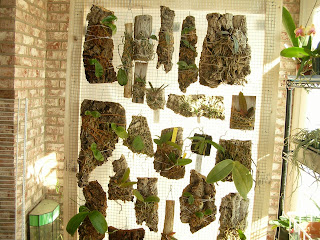 This is a new plant stand I recently completed. It will considerably shorten my daily watering routine by allowing me to water many of the mounted plants with a watering can rather than taking them in batches to a sink.
This is a new plant stand I recently completed. It will considerably shorten my daily watering routine by allowing me to water many of the mounted plants with a watering can rather than taking them in batches to a sink. It consists of hard wire cloth affixed to a simple pine frame with a plywood base. There is plastic sheeting in the back, simply attached so that it will be easily replaced if it develops an algae coating. There is a plastic bin on the bottom to catch drip and to house a few phrags and some ferns. Also, there are wheels on the bottom to easily allow me to move the stand around as needed for watering.
It consists of hard wire cloth affixed to a simple pine frame with a plywood base. There is plastic sheeting in the back, simply attached so that it will be easily replaced if it develops an algae coating. There is a plastic bin on the bottom to catch drip and to house a few phrags and some ferns. Also, there are wheels on the bottom to easily allow me to move the stand around as needed for watering.

Labels:
orchid culture,
the lazy gardener
Wednesday, March 4, 2009
Temperature Sensitive Pigments

The most interesting thing about it though, is that it seems to have temperature sensitve pigment production. I brought it up from our unheated basement (~55F this time of year) to a cool window in the living room (room ~67, window probably a bit less, especially at night). At the time, it had a few open flowers, several buds that opened soon after, and two buds at the top that needed to develop a bit before opening. All of the first flowers to open are white with a pink blush toward the edge. The last two younger buds are the ones you see above with the strong pink edges on the petals. The anther cap is also pink in these flowers. This must be a response to the warmer temperatures during the critical stages of bud development for these two. I think next year I'll bring it upstairs earlier, or just keep it up here permanently, so that all the flowers will be this vibrant!
Growing info for these plants:
These are dwarf nobile type, reaching perhaps a height of ~18 inches (currently ~10 inches tall in 2.5 inch pots). Nobile group plants are deciduous, meaning they generally shed their leaves every year. Don't worry when the leaves start looking a little blah in winter than fall off as long as the canes look good.
Grow like a phalaenopsis in Summer, but increase light and decrease temperature somewhat in Winter. If they don't flower for you they're not cool enough at night. I keep my plants on a screened porch in Summer, leaving them out in the fall until it is quite chilly at night, then put them in my unheated basement under artificial light. Great for rooms with extra drafty windows or little to no heat in winter.
Labels:
in bloom,
orchid culture,
orchids
Subscribe to:
Posts (Atom)
